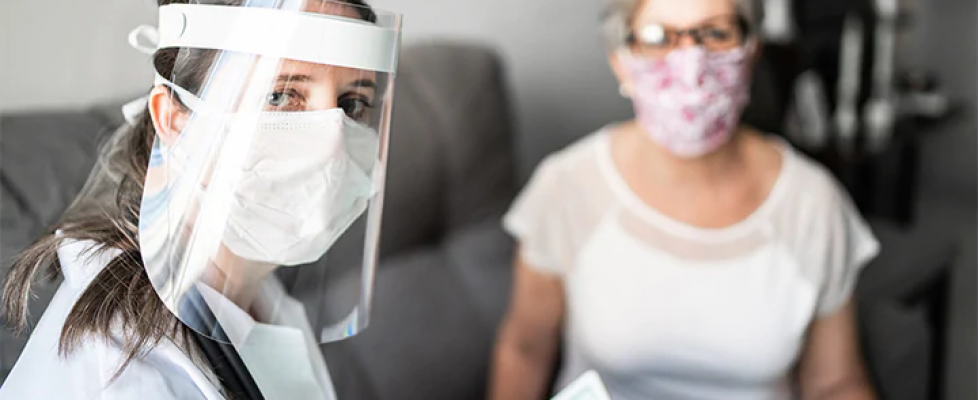Beyond Telehealth: Bringing Care to Patients’ Homes
COVID-19 has created a telehealth boom, and it’s fantastic. The pandemic has pushed telehealth forward at least 10 years — no small feat, given healthcare lags about 10 years behind other industries in digital innovation. But, as is often the case with U.S. healthcare, we’re over-relying on the latest trend and ignoring the fact that it’s only a part of the bigger picture. By touting telehealth as the panacea for our healthcare woes, we’re leaving huge gaps in providing care.
Our systems are designed from a place of privilege — what works when everything goes right. For a healthy, active, tech-savvy person in a safe home environment who has established care, telehealth is perfect. We can pop it in as another tool, and never miss a beat. But any deviation from this and there can be huge gaps. How does healthcare reach those people who aren’t tech-savvy? Those who are concerned about coming into the hospital but don’t own a computer or don’t want to use a phone? How do we reach the at least 21 million people who lack broadband access or the more than 550,000 people who experience homelessness on a given night?
The issues that healthcare sees in a person are exacerbated by trying to care for people remotely: language barriers, no support, food insecurity, and unsafe homes. And while telehealth is popular among both patients and practitioners, practitioners learn things from seeing you in person: how you walk, how you smell, all the non-verbal cues that you give to us tell a story beyond just your words.
I’m not suggesting that we throw telehealth aside and all come back to the hospital. In fact, I think that’s an awful idea. There is merit in virtual visits, whether they’re synchronous or asynchronous, done via a Zoom video call or just by phone. All of that has a place in the future of healthcare. There is benefit for all when patients don’t have to physically navigate a hospital and figure out where to park, or worry about having to schedule several hours in order to make a trip to a clinic and then actually be seen. I’m also not advocating that we design for every single outlier, which is impossible. I do believe that we have to design for the most challenging scenario — one which is likely to serve well those people who benefit most from fixing barriers to access and care.
Take, for example, an older woman who qualifies for both Medicare and Medicaid (as nearly 7.2 million seniors do). She lives alone, is hard of hearing, and doesn’t have access to a computer. She qualifies as one of the 13 million people over age 65 who is “telemedicine unready.” She recently tripped and hit her leg on a table, and with COVID, she is hesitant to come into an office for evaluation. A visit by phone doesn’t let her practitioner see her leg, and may be limited by what she is able to hear. A visit to her home, however, allows for a visual assessment — not just of her, but of the rugs on her floor that increase her likelihood of tripping; of an almost-bare pantry that shows a need for additional services; and of an old oven pulled into her room for heat, which she’s never mentioned before.
Collectively, we have to recognize the need for moving care outside of the four walls of a hospital or clinic and into patients’ homes. As someone who has done visits in people’s homes for the past 6 years as a Nurse Practitioner, I know the benefits of seeing first-hand how my patients live: who they live with, what safety issues they have, how much food is in their refrigerator. My patients are receiving hospice services, a specialty where home-based care is the norm. I learn so much from watching how families interact with each other (or don’t, as the case may be), from seeing where medications are kept and how people maneuver through the house. This information has long been missing from hospital-based care, and yet it’s what practitioners need to improve outcomes.
With ongoing concerns from the pandemic, we have a chance to rethink care delivery, and in so doing, collect valuable information in more meaningful ways than just a check-box on a questionnaire. Certainly, there are needs for a hospital: emergencies, critical care, and surgery, to name a few. But outcomes associated with hospital-at-home models, PACE programs, and home-based primary care support moving in-person care into the home for both straight-forward and complex patients. Incorporating home visits into the plan of care, such as with Mayo Clinic’s recent advanced-care-at-home hybrid model, has to become healthcare’s standard and not its exception.
We know that people are delaying care due to fears of going to a hospital or office. If telehealth were a perfect solution, there would be no delay, simply a transition to a different type of visit. But the fact is that telehealth leaves gaps, and if people are delaying care out of concern for coming to us, then we need to figure out all the ways that we can go to them.

